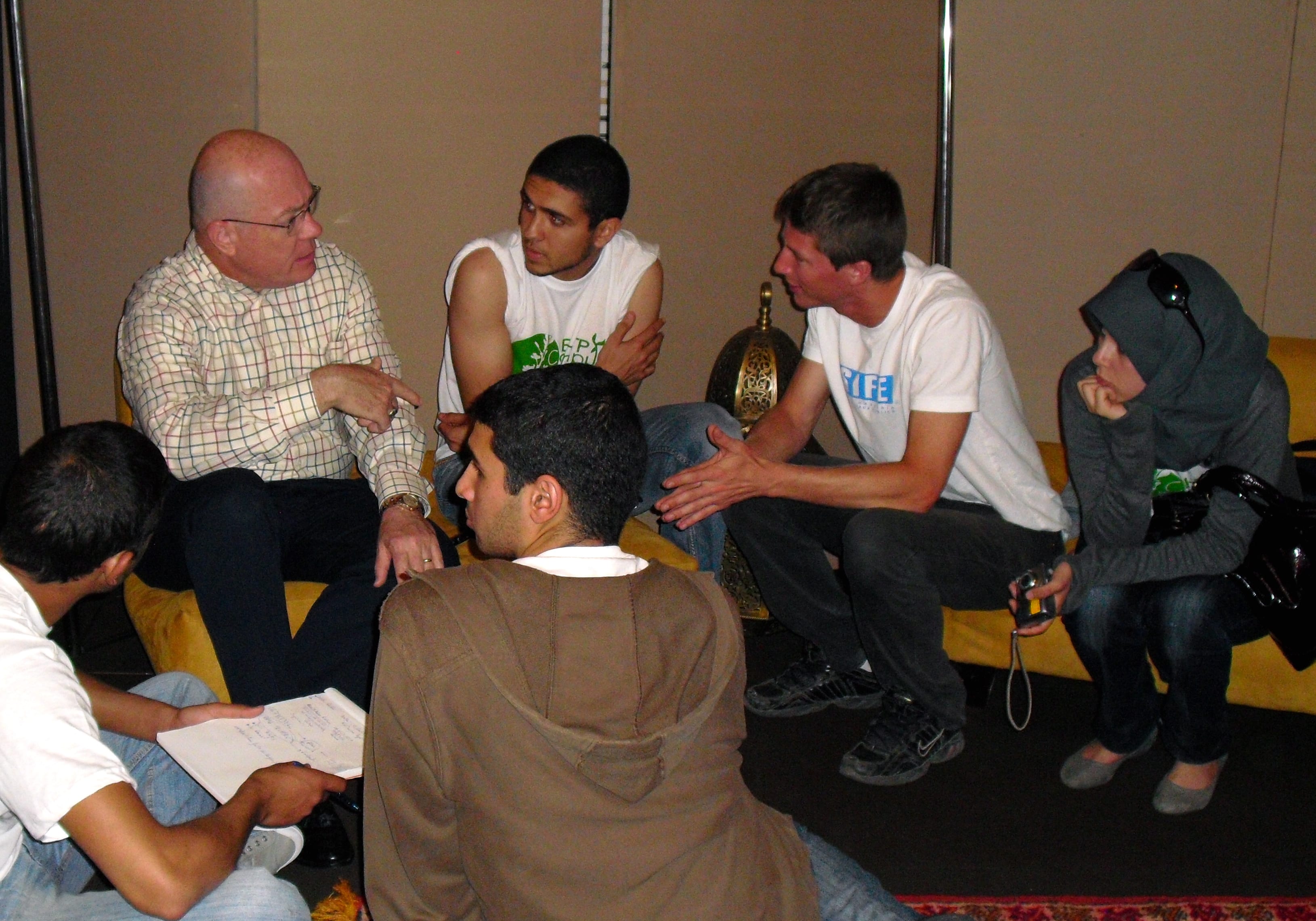
Under Secretary of State for Public Diplomacy and Public Affairs Tara Sonenshine, who delivered the annual Walter Roberts Lecture at George Washington University last Thursday, comes from a serious press and media background. She is the recipient of 10 News Emmy Awards and other awards in journalism for broadcast programs on domestic and international issues. She has also worked as strategic communications adviser to Internews and the International Women’s Media Foundation, among a number of other international organizations.
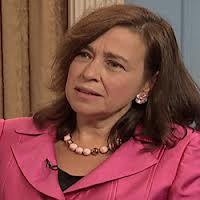 So it was all the more striking how prominently cultural diplomacy featured in her comments last Thursday, just as it does in many of her other communications — including the U.S. public diplomacy highlights she publishes every few weeks.
So it was all the more striking how prominently cultural diplomacy featured in her comments last Thursday, just as it does in many of her other communications — including the U.S. public diplomacy highlights she publishes every few weeks.
This is a reminder that the Under Secretary recognizes and embraces the fact that cultural programming IS communication. It is an essential diplomatic tool that enables the U.S. to persuade influential people to listen to us with an open mind; allows us to share knowledge and skills with potential international partners and allies; and helps us attract positive attention via mass media and digital media.
As Harvard scholar Joeph Nye has noted, the scarcest information resource in the 21st Century is likely to be the audience’s attention span. Here in the U.S., despite the plethora of contemporary media distractions, most citizens still pay some attention to what our own government says, because we know it might affect us directly, and also because we conceive of every citizen having a watchdog role. Certainly U.S. journalists see scrutiny of government as an obligation.
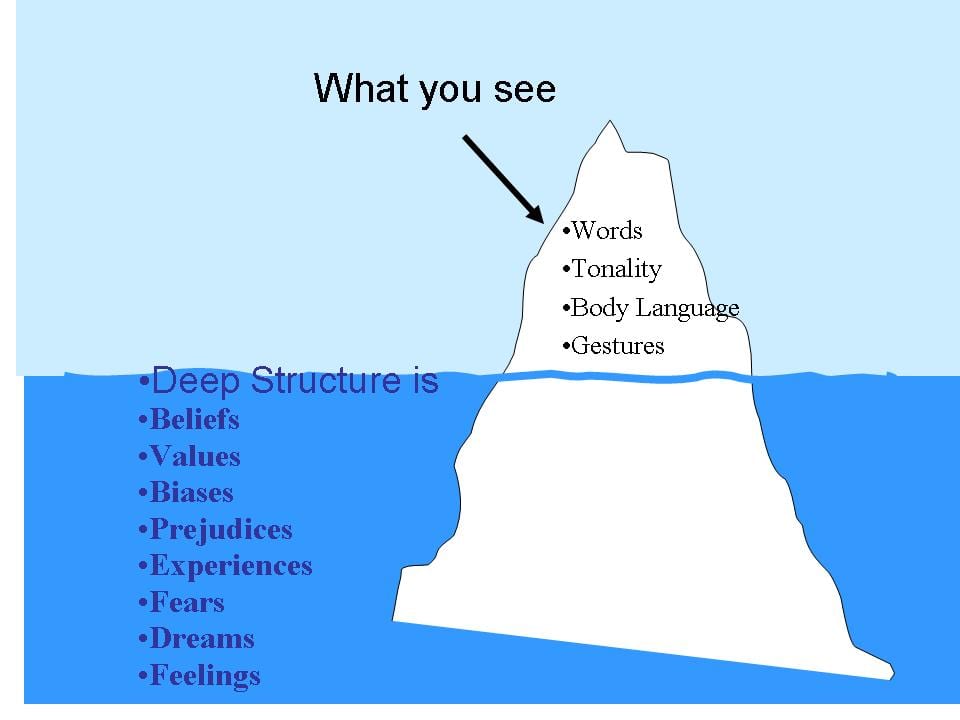
But it would be a mistake to think that official U.S. statements and policy explanations get even the modest automatic hearing abroad that they do at home. People are certainly interested in what the U.S. is up to, but they have a host of non-U.S. sources for that information that are more familiar to them, more trusted, and frequently more accommodating to their preconceptions.
Overseas, it takes creativity and insight to increase the chances that people will listen to U.S. officials with an open mind, and be prepared to respond accordingly.
This is why public diplomacy practitioners know that cultural programming is increasingly vital to the achievement of foreign policy goals. Some cultural programs serve as the proverbial “picture worth a thousand words,” projecting the essence of American policies, principles, and values via local mass media and fast-growing new digital media. Some cultural programming works as a powerful teaching tool to help influential people abroad understand (if not necessarily accept) both U.S. foreign affairs priorities and fundamental American principles.
More fundamentally, cultural programming fosters relationships and understanding between foreign officials and U.S. diplomats who will be called on, sooner or later, to work on contentious issues across the table from one other. It helps sustain generalized affinities even as individuals come and go in the diplomatic service. And it helps connect the real global communicators of the 21st century: journalists, activists, scholars, researchers, teachers, writers, artists, scientists, and entrepreneurs, as well as young people just joining the conversation.
The following recent U.S. public diplomacy highlights show the variety of ways in which cultural programming communicates. These highlights, published in January by the Office of the Under Secretary, are here sorted into three categories: Talking, Teaching, and Spreading the Word.
1) Talking — recognizing the people who are (or are likely to become) influential, and bringing them together across borders for focused and purposeful exchange of ideas.
- Alumnus Hassen Ould Ahmed was recently appointed Deputy Director of Mauritania’s Cabinet. Ahmed was a 2008-2009 Hubert H. Humphrey Fellow at Penn State University. Meanwhile, Armenian political magazine De Facto named Edmon Marukyan, an alumnus of the Hubert H. Humphrey Program 2010 and previously the International Visitor Leadership Program (IVLP), “Member of Parliament of the Year.” Marukyan was elected to parliament in spring 2012.
- Public Affairs Section Jerusalem hosted Oberlin College Professor of History Dr. Gary Kornblith, who spoke on American democracy at An-Najah University, Birzeit University, and Al Quds Open University. Dr. Kornblith also discussed the possibility of establishing an American Studies Program at the universities, meeting with university staff and academics at an Embassy reception designed to nurture cultural dialogue and advance the pursuit of American Studies.
- At Rich Mix, East London (U.K.), playwright Wajahat Ali participated in an evening monologue and discussion with members of the Muslim arts community. The event attracted artists, writers, students and community leaders, including many women. An accomplished Muslim-American writer and an engaging speaker, Mr. Ali is comfortable with both his American and his Muslim identities, and there was much discussion about the contrast between American and British Muslims on that topic.
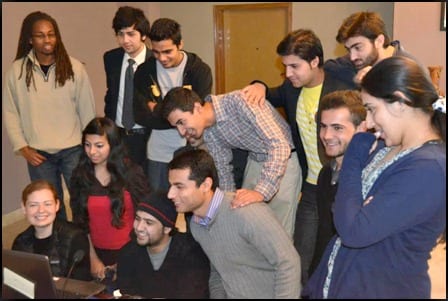 On January 5-6, while India and Pakistan faced each other on the cricket pitch, teams of exchange program alumni from India, Pakistan, and Bangladesh engaged in the xBorder Games. Using social media tools like Google+, Storify, and Twitter, two teams comprised of alumni from each country competed in a digital scavenger hunt. The xBorder Games connected 45 alumni separated by geographic, cultural, and linguistic lines, created new friendships, and increased cross-cultural understanding. U.S. Embassies Islamabad, New Delhi and Dhaka organized the event.
On January 5-6, while India and Pakistan faced each other on the cricket pitch, teams of exchange program alumni from India, Pakistan, and Bangladesh engaged in the xBorder Games. Using social media tools like Google+, Storify, and Twitter, two teams comprised of alumni from each country competed in a digital scavenger hunt. The xBorder Games connected 45 alumni separated by geographic, cultural, and linguistic lines, created new friendships, and increased cross-cultural understanding. U.S. Embassies Islamabad, New Delhi and Dhaka organized the event.
- Paralympian and Fulbright Scholar Yevgeniy Tetyukhin spoke about disability policy to an audience of special education teachers and administrators at the University of Guam. A professor, two-time Paralympian, and lifelong disability advocate, Tetyukhin is spending a year at the University of Hawaii at Manoa’s Center on Disability Studies, researching disability policy in the context of globalization and multicultural diversity.
- Unconventional artists and activists narrate their own stories on a new VOA program that seeks to connect underground communities in Iran and the rest of the world. The twice-monthly TV and web program called ZirZameen is produced by Voice of America’s Persian Service and is available in both English and Farsi editions. The show, hosted by Mehrnoush Karimian, premiered in December and is available on social media sites, the VOA Persian satellite stream and on Livestation, a 24/7 Internet streaming platform.
- The U.S. Ambassador to Korea hosted a New Year’s party for the Embassy’s online friends. Out of 35,000 people who follow the post’s various social media accounts, a diverse group of 20 were invited based on their online activity. The Ambassador blogged about the party, and the Embassy will post an “Ask the Ambassador” YouTube video highlighting the event. The Ambassador will continue this type of online-offline engagement with innovative netizens in the future.
2) Teaching — transferring knowledge and skills that are essential in civic life, political life, and international relations. Cultural programming promotes retention and “useability” of new knowledge through dialogue, debate, and learning-by-doing. Two-way knowledge transfer and “paying know-how forward” are frequent outcomes of cultural programming.
- Pilarani Phiri from Zodiak Broadcasting radio station in Malawi – a participant in the State Department Foreign Press Center’s (FPC) 2012 Elections program for visiting journalists – reported that he
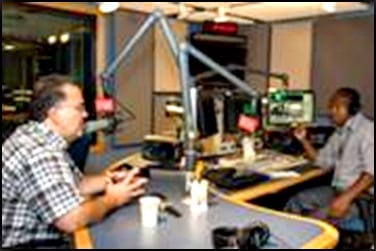 secured the first live phone interview with a Malawian president as a result of his U.S. program experience. In his words: “one thing I learned while covering the elections is that the American President is always scrutinized by the public. Immediately I arrived home I got in touch with our ‘White House’ to have the President answer questions from the public. I am proud to announce that on December 31, I was the first Malawian journalist to have a live phone interview with the President where people posed questions to [him], a thing that has never happened before in my country.”
secured the first live phone interview with a Malawian president as a result of his U.S. program experience. In his words: “one thing I learned while covering the elections is that the American President is always scrutinized by the public. Immediately I arrived home I got in touch with our ‘White House’ to have the President answer questions from the public. I am proud to announce that on December 31, I was the first Malawian journalist to have a live phone interview with the President where people posed questions to [him], a thing that has never happened before in my country.”
- For four months, hundreds of Indonesian English teachers gathered every Saturday morning to take part in the series “Shaping the Way We Teach English,” taught by the [U.S. Embassy] Regional English Language Officer and English Language Fellows. The teachers came to @america [the high-tech American Center] in Jakarta or participated via digital link from the Consulate in Medan and the American Corner in Yogyakarta.
- U.S. Embassy Kampala’s Information Officer gave a presentation at the “Writing Our World” (WOW) workshop at Makerere University, coaching participants on using social media to broadcast their voices and market their writing. Facebook, Twitter, and blogging were introduced as tools to expand the young writers’ network and increase attention to their work. The Embassy has also given grants to facilitate the activities of Writing Our World through readers and writers clubs in 10 schools. WOW’s leader is a member of the Embassy’s Youth Council.
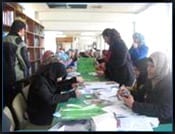 Jerusalem: The board game Monopoly has proven a potent tool in fostering the entrepreneurial spirit among Palestinian youth, while simultaneously introducing a mainstay of American culture. American Corner Salfeet hosted 20 undergraduate students from Al Quds Open University for a discussion about business plans, barriers to entry, and board games with a visiting U.S. diplomat.
Jerusalem: The board game Monopoly has proven a potent tool in fostering the entrepreneurial spirit among Palestinian youth, while simultaneously introducing a mainstay of American culture. American Corner Salfeet hosted 20 undergraduate students from Al Quds Open University for a discussion about business plans, barriers to entry, and board games with a visiting U.S. diplomat.
- Seven officials from Zambia’s Ministry of Tourism traveled to the U.S. in January on an IVLP program to enhance their planning of the 20th session of the United Nations World Tourism Organization General Assembly, which will take place in Zambia in August 2013. During the program the officials examined how to plan a world conference, including best practices, leveraging partnerships, and capitalizing on them for longer-term benefit beyond the conference.
3) Spreading the word – via local media coverage or on digital media. While the previous two genres of cultural programming are designed to make a significant impact on the immediate participants, the purpose of this third type is to spark positive interest among the many.
- U.S. Embassy Caracas held its annual “Baseball Visa Day” during which Venezuelan players in the U.S. major leagues and their family members obtain visas for the upcoming season. This year some 40 major leaguers and their families visited the Consular Section for their visas, and afterwards participated in a brief ceremony and reception with coverage by multiple print and television media outlets. Chargé d’Affaires (CDA) James Derham reminded those present that baseball is just one of many historic and cultural ties uniting Venezuela and the United States, and congratulated the players for an unprecedented season in which one Venezuelan won the batting Triple Crown, one pitched a no-hitter, another pitched a perfect game, and nine played in the World Series. During this event, Embassy Caracas took the opportunity to promote its youth outreach program “Béisbol y Amistad” (Baseball and Friendship), now in its seventh season.
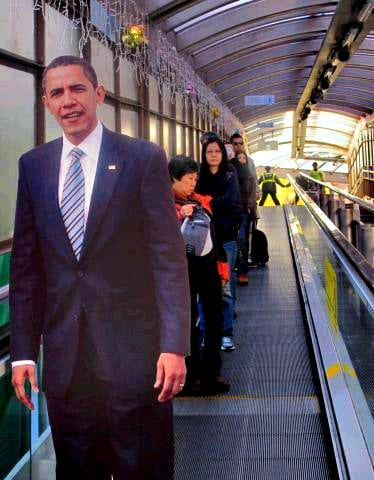 In the lead-up to the U.S. Presidential Inauguration, Consulate Hong Kong began a social media project that included photos, videos and travelling cardboard cutouts of President Obama and the First Lady. Consulate Hong Kong Facebook posts of “President Obama” riding the Mid-Levels Escalator and standing in a Mass Transit Railway (MTR) station generated 42 comments, and 213 likes. Public Affairs Section Hong Kong will complete the project on January 21, 2013 with a video montage of the cutout President’s “tour” of Hong Kong.
In the lead-up to the U.S. Presidential Inauguration, Consulate Hong Kong began a social media project that included photos, videos and travelling cardboard cutouts of President Obama and the First Lady. Consulate Hong Kong Facebook posts of “President Obama” riding the Mid-Levels Escalator and standing in a Mass Transit Railway (MTR) station generated 42 comments, and 213 likes. Public Affairs Section Hong Kong will complete the project on January 21, 2013 with a video montage of the cutout President’s “tour” of Hong Kong.
- The Innovation Generation Facebook page of State Department’s IIP Bureau hosted Monica Dodi, co-founder of MTV Europe and The Women’s Venture Capital Fund, on its “Ask the Entrepreneur” series, which features accomplished American entrepreneurs. The discussion sparked questions from around the globe including from India, Indonesia, Mauritania, Mexico, and Pakistan.
 The U.S. Consul General in Munich spoke to students and faculty of “Berufsschule 4,” an off-the-beaten-track school in Nuremberg. He addressed U.S.-German relations, the U.S. presence in Bavaria, and economic and commercial ties, and tackled tough questions about car emissions, Guantanamo, gun control, and social media topics. The MeetUS speaker program is a core part of Mission Germany’s youth outreach, and the discussion was live Tweeted to highlight the event to a broader audience.
The U.S. Consul General in Munich spoke to students and faculty of “Berufsschule 4,” an off-the-beaten-track school in Nuremberg. He addressed U.S.-German relations, the U.S. presence in Bavaria, and economic and commercial ties, and tackled tough questions about car emissions, Guantanamo, gun control, and social media topics. The MeetUS speaker program is a core part of Mission Germany’s youth outreach, and the discussion was live Tweeted to highlight the event to a broader audience.
- Bosnian Brooklyn Nets Player Interview Makes Front Page: The State Department’s New York Foreign Press Center assisted the U.S. Embassy in Sarajevo in securing an interview with Brooklyn Nets player Mirza Teletovic – a Bosnian basketball star who has recently joined the NBA – in Dnevni Avaz (Daily Voice), the leading Bosnian newspaper and news website.
- In January, [State Department] hosted 20 Youth Ambassadors from Costa Rica, the Dominican Republic, Guatemala, and Panama for a reception and meeting with the Acting Assistant Secretary for Western Hemisphere Affairs (WHA), which promoted the event on social media along with the Bureau of Educational and Cultural Affairs and the relevant U.S. Embassies; Embassy San José alone received nearly 6,000 Facebook page views and 300 likes.
All the above constitute just a few of the highlights shared by the Under Secretary’s office for January alone. January’s highlights in turn constitute a tiny sliver of the cultural programming that takes place week in, week out at every U.S. Embassy and Consulate around the world. Most of it is targeted to advance specific foreign policy goals, and just about all of it is conceptualized strategically.
Each example is also a reminder that cultural diplomacy IS communication. The U.S. can only benefit from greater use of cultural programming to advance U.S. foreign affairs priorities.


1 thought on “How Does Cultural Diplomacy Communicate? Let Me Count the Ways”